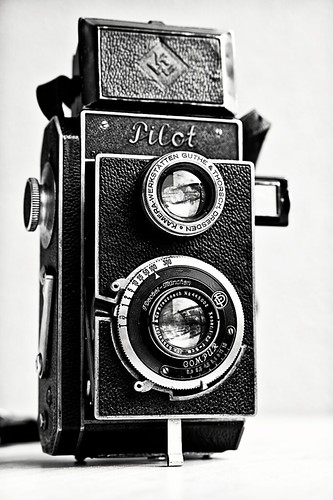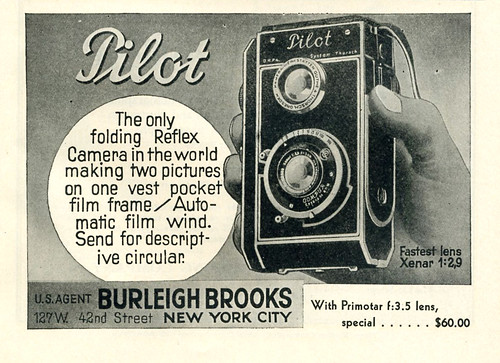Pilot Reflex

|
| K.W. Pilot Reflex image by lumowerkx (Image rights) |
The Pilot (often called the Pilot Reflex, though the camera itself is only marked 'Pilot', and contemporary advertisements use this name for it) is a folding twin lens reflex camera for 3x4 cm pictures on 127 roll film. It was made by Kamera Werkstätten Guthe & Thorsch in Dresden, Germany between 1931 and 1937.[1] The folding design is unusual for a TLR, but not unique; the German Perfekta, Superfekta and Zeca-Flex are other examples.
The camera was made with a number of taking lenses: examples have been seen with an 5 cm f/2.9 Xenar, an 5 cm f/2.8 Zeiss Tessar or 4.5 cm f/2.0 Biotar, and a 5 cm f/2.7 Meyer Makro-Plasmat. McKeown lists other lenses including a 5 cm f/3.5 Elmar. The viewing lens is marked only for KW.
As most TLR cameras, the Pilot has a folding waist-level finder, with a focusing loupe, mounted in a plate that shades the whole focus hood when unfolded. There is also a folding reverse-Galilean viewfinder on the left side of the body, which facilitates vertically-oriented photographs (the waist-level focusing hood does not have the common 'sports-finder' feature). Curiously, the Galilean finder is placed at the same height as the viewing lens; it might seem wiser to put it closer to the taking lens to reduce the parallax error. The frame counter is a ruby window in the back of the camera, with a sliding cover. The camera has a dual-stroke advance lever. This does not cock the shutter: the Compur shutter is set and tripped with levers on the shutter body.
The camera is focused with a knob on the right side of the body, above the advance lever.
| |||
| German TLR () | |||
|---|---|---|---|
| 35 mm | Contaflex | Flexilette | Optima Reflex | ||
| 3×4 | Pilot Reflex | ||
| 4×4 | Baby Rolleiflex (1931) | Baby Rolleiflex (1957) | Karma-Flex | ||
| 6×6 | Altiflex | Amplion Reflex | Brillant | Flektar | Flexo | Flexora | Flexora II | Flexora III | Foth-Flex | Ikoflex 1 | Ikoflex II | Ikoflex Ia | Ikoflex Ic Ikoflex Favorit | Karma-Flex | Mentorett | Montiflex | Peerflekta | Perfekta | Photina Reflex | Plascaflex | Reflecta | Reflekta | Reflekta II | Rica Flex | Rocca Automatic | Rocca Super Reflex | Rolleiflex | Rolleicord | Rollop | Superb | Superflex | Trumpfreflex | Vitaflex | Weltaflex | Wirgin Reflex | Zeca-Flex | ||
| 6×9 | Superfekta | ||
Notes
- ↑ McKeown, James M. and Joan C. McKeown's Price Guide to Antique and Classic Cameras, 12th Edition, 2005-2006. USA, Centennial Photo Service, 2004. ISBN 0-931838-40-1 (hardcover). ISBN 0-931838-41-X (softcover). p 584.
Links
- The notes on KW at Dresdner Kameras show a Pilot with a 5 cm f/2.8 Tessar, and an advertisement for the camera with the Biotar.
- Examples sold at Westlicht Photographica Auction in Vienna (now Leitz Photographica Auction):
- Pilot serial no. 2853, with 4.5 cm f/2 Zeiss Biotar, sold at the fourteenth auction, on 30 November 2008.
- Pilot, serial no. 2527, with 5 cm f/2.7 Meyer Makro-Plasmat, sold at the first auction, on 15 November 2002.
- Pilot (no serial no. given), with 5 cm f/2.9 Xenar, also at the first auction.
- KW Pilot review at Mike Eckman.com
